Research Article
Evaluating Past Surface Air Temperature Change in Tabriz, Iran Using Hourly-Based Analyzing
Department of Agronomy and Plant Breeding, Shahrood University of Technology, P.O. Box 36155-316, Shahrood, Iran
In recent years, the climate change phenomena, especially change of surface air temperature, have been extensively studied. Generally, in the last century, the global temperature has increased 0.7 °C and 1990s were the warmest decade on record (Rosenzweig et al., 2000). Although there is more evidence for warming in different regions (Tao et al., 2003), some reports suggesting that surface air temperature has had decreasing trend, which is related to quite inhomogeneous in various respects. For instance, Skinner and Gullett (1993) indicated that in Atlantic, Canada, autumn and winter temperature (Tmax and Tmin) has diminished.
Besides the spatial and seasonal variability of the temperature trend, reports suggesting that globally averaged minimum temperatures (Tmin) continue to increase at a faster rate than the maximum temperatures (Tmax), resulting in a narrowing of the diurnal temperature range (Karl et al., 1993; Razuvayev et al., 1997; Vose et al., 2005). In Beiging, China it has been shown that the linear rate of increase in Tmin is 4.08 °C/100 year; whereas the Tmax decreases with a linear rate of 2.45 °C/100 year (Karl et al., 1993; Xie and Cao, 1996). Other reports for China indicating that in north regions, increasing trend of Tmin for period 1951-1990 has been more sensible, when compared to Tmax (Tao et al., 2003). Analyzing daily and monthly maximum and minimum surface air temperatures at 66 weather stations over the eastern and central Tibetan Plateau for temporal trends also confirmed the asymmetric pattern of greater warming trends in Tmin or nighttime temperatures as compared to the daytime temperatures (Liu et al., 2006). In central Europe, despite of low-lying stations for which the above named behavior has been found, data from mountain top stations show a similar increase for both Tmin and Tmax of daily temperatures (Weber et al., 1994). In Iran, results regarding Kermanshah showed that except for January, February and March, the increase in Tmin is considerable for all other months, especially June (Gholipoor et al., 2006); whereas Tmax appears to show increasing trend only for April, May, June and August; in other regions, like Gorgan, Tmin appears to be changed only in May; on the other hand, Tmax shows no statistically change in all months (Ghorbani and Soltani, 2002). Asymmetric change has been also reported for many other regions/countries, including southeastern Europe (Brázdil et al., 1996), United States and Canada (Karl et al., 1984) and Italy (Brunetti et al., 2000).
As mentioned, the change of surface air temperature has been extensively studied as Tmax and Tmin based evaluation. It seems that such evaluations provide no detailed information about temperature change, when pattern of diurnal temperature change is asymmetric. For example, when temperature change is significant only for Tmin, Tmax Tmin based results provide no information about the number of nighttime h with temperature change. Such detailed information are needed for decision making and managing, especially plants in which growth and development processes are highly dependent on temperature of day and night time moments. This study was aimed to evaluate climate-change-resulted temperature increase/decrease in Tabriz, Iran, using hourly-based-analyzing and comparing them with trends of Tmax and Tmin.
The historical weather data for Tabriz (38 ° 50` N, 46 °7` E and 1361 m asl), Iran, was used for this evaluation. Data set was years 1966-2004 and contained daily values for sunshine hours, Tmax, Tmin and rainfall. The values of Tmax and Tmin were used for calculating hourly temperature, using the model of Cesaraccio et al. (2001). Such estimations have been extensively used by many researchers for different goals (Fernandez, 1992; Floyd and Braddock, 1984; Goudriaan and Waggoner, 1972; Johnson and Fitzpatrick, 1977; Jones et al., 2003; Keating et al., 2003; Kline et al., 1982; Lemon et al., 1971; Parton and Logan, 1981; Snyder et al., 1999; Wilkerson et al., 1983; Worner, 1988). This is due to this fact that hourly data records are currently available for only a limited number of stations because of instrumentation constraints in rural agriculture areas and memory limitations of computers sorting hourly (or even more frequent) temperature observations.
The planting date for spring (chickpea, lentil, barley and maize) and winter (wheat) crops were first determined; the 7 day with no rainfall and with mean temperature above the base temperature were considered as planting date for spring crops, using long-term weather data; planting date for winter wheat calculated based on required Growing Degree Days (GDD) for rosette growth before occurrence of growth cession which is imposed by winter freezing; growing period for each crop was calculated on the basis of required GDD from planting to maturity. A simple Qbasic program was used for averaging hourly temperature over month, over growing period of crops and over yearly period; like hourly temperature, the averaged values of Tmax, Tmin and mean temperature were also calculated.
If the changing trend of temperature, for example, to be increasing across first 20 years, but decreasing across last 19 years, it may be described by quadratic model and should be considered as periodic fluctuation in temperature, rather than consistent change, which is described by linear model. Therefore, it was used only a simple linear regression model Y = a+bX to determine rate of increase/decrease (b) in temperature; in this equation, Y is dependent variable (temperature), X year, a intercept and b slope of regression line; the value of parameters (a and b) was calculated, using the procedure REG in SAS (SAS, 1989).
The rate of change (value of b) for temperature of 1 to 5 h am was presented in Table 1. Warming was statistically considerable for January, February, June, July, August, September and October, but negligible for other months. The rate of warming was the same across these h for August (0.046 °C year-1), September (0.051-0.052) and October (0.058-0.059), but ranged from 0.092 to 0.096 for January, 0.082 to 0.085 for February, 0.058 to 0.060 for June and 0.039 to 0.042 for July. Based on these values, the highest and 2nd highest warming rate has been happened for January and February, respectively; the lowest warming has been done for July. It was equal to 0.029-0.030 for barley, 0.036 for chickpea, 0.037 for lentil, 0.040-0.041 for maize, 0.036-0.037 for wheat and 0.049-0.050 for yearly period.
The values of b for 6-10 h presented (Table 2). Based on values of Table 2 and 1, it can be said that the warming tended to be statistically negligible for 1-10 h in March, April, May, November and December, for 6-10 h in July and for 9-10 h in January. Results regarding 6-10 h indicate that with hour incrementing, the rate of warming showed decreasing trend for January (only across 6-8 h for which the warming was significant), June, September, but increasing trend for October and February; in August, it was nearly constant (0.045-0.046 °C year-1). Averaged over growing periods and over yearly period, these h had statistically significant warming; the rate of warming showed directed-change across named h for barley, but inversed-change for maize, wheat, yearly period and nearly no change for chickpea and lentil; like 1-5 h, the highest warming rate was found for yearly period.
Warming for 11-15 h was significant only in February, June, August, September and October (Table 3). In contrast to 1-10 h , warming rate was higher for 11-15 h in February [0.097 °C year-1 (for 11 h) to 0.099 (13-15), versus, 0.083 (1) to 0.095 (10)] and October [0.064 (11) to 0.065 (12-15),
| Table 1: | The rate of change (value of b in equation Y = a+bX) and its probability level (P) for averaged hourly temperature (1 to 5 am) over month, over growing period of 5 crops and over year ( °C year-1) during past 39 years for Tabriz, Iran |
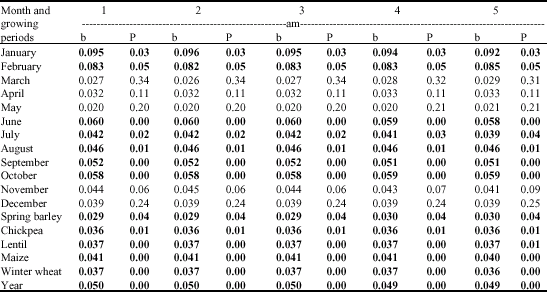 | |
| The bold values are statistically significant | |
| Table 2: | The rate of change (value of b in equation Y = a+bX) and its probability level (P) for averaged hourly temperature (6 to 10 am) over month, over growing period of 5 crops and over year ( °C year-1) during past 39 years for Tabriz, Iran |
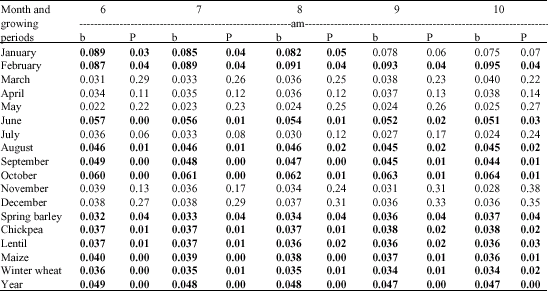 | |
| The bold values are statistically significant | |
| Table 3: | The rate of change (value of b in equation Y = a+bX) and its probability level (P) for averaged hourly temperature (11 to 15 ) over month, over growing period of 5 crops and over year ( °C year-1) during past 39 years for Tabriz, Iran |
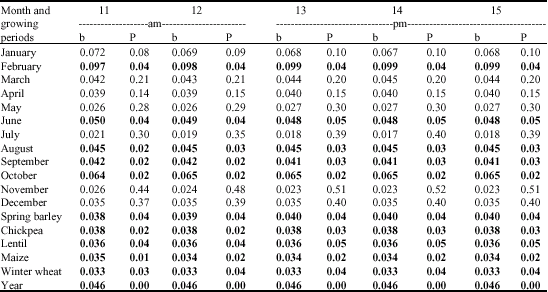 | |
| The bold values are statistically significant | |
versus, 0.058 (1-3) to 0.064 (10)], but lower in June [0.050 (11) to 0.048 (13-15), versus, 0.060 (1-3) to 0.051 (10)] and September [0.042 (11-12) to 0.041 (13-15), versus, 0.052 (1-3) to 0.044 (10)]; on the other hand, it was nearly constant (0.045-0.046) across these h for August. Considering these values and those of other months, it becomes clear that in first h of morning, as mentioned previously, the highest and 2nd highest warming rates have happened for January and February, respectively, but due to difference in trends of warming rate, February possessed the highest values after 6 am and that of January statistically equaled to zero after 8 am; across 1-10, warming rate appeared to show relatively rapid directed-change for February and October, but inversed-change for June and September; with incrementing from 11 to 16, it had relatively slow upwardly change for February, but downwardly change for June; the change of warming rate across these h was nearly negligible for October and September. Compared to 1-10 h, warming rate was considerably higher for 11-15 h in growing period of barley and sensibly in that of chickpea, but lower in that of maize, wheat and in yearly period; it was nearly the same in growing period of lentil.
The values of b for 16-20 h, which were positive, appeared to be statistically considerable only in February, June, August, September and October (Table 4); in January, the warming rate was significant only for 20 h; with incrementing h from 16 to 20, warming rate showed downwardly trend for February and October, but upwardly trend for June and September; it was nearly constant across these hours for August. Despite of chickpea and lentil, for which the warming rate indicated no change across 16-20, it displayed nearly directed-change for maize, wheat and for yearly period, but inversed-change for barley.
The warming was significant for January (it ranged from 0.085 °C year-1, for 21 h, to 0.094 for 24 h), February (0.089 to 0.083), June (0.056 to 0.059), August (0.046 to 0.046), September (0.048 to 0.051), October (0.061 to 0.059) and July (0.039, for 23, to h 0.041 for 24 h) (Table 5). It was also significant for barley (0.033 to 0.030), chickpea (0.037 to 0.036), lentil (0.037 to 0.037), maize (0.039 to 0.041), wheat (0.035 to 0.037) and yearly period (0.048 to 0.049).
In February, June, August, September and October, the value of b was significant for all cases, including Tmax, Tmin and mean temperature (Table 6); among these months, August appeared to have nearly the same value of b for Tmax and Tmin; compared to Tmax, value of b was higher for Tmin in September and June, but lower in February and October. In July, that of b was statistically considerable only for Tmin. In January, it was true for both Tmin and mean temperature. Rate of warming for Tmin was about two times higher in January, as compared to July. For growing period of crops and yearly period, value of b was significant for Tmin, Tmax and mean temperature; warming found to be faster for Tmin in growing period of wheat, maize, yearly period, but slower in that of chickpea and barley; warming rate nearly appeared to be the same for lentil. Considering these results it is cleared that there is no values of b<0, reflecting no climate-change-resulted decrease in temperature for period from 1966 to 2004 in Tabriz, Iran; this is in agreement with reports which are most evident, i.e., warming (Tao et al., 2003), but not with findings of Skinner and Gullett (1993); additionally, as it has
| Table 4: | The rate of change (value of b in equation Y = a+bX) and its probability level (P) for averaged hourly temperature (16 to 20 ) over month, over growing period of 5 crops and over year ( °C year-1) during past 39 years for Tabriz, Iran |
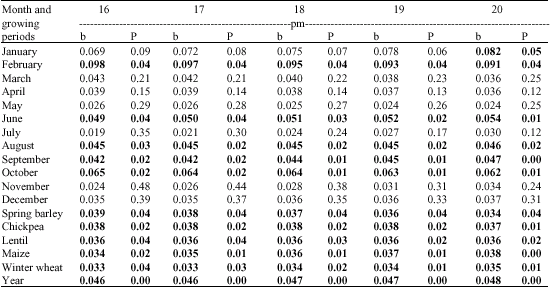 | |
| The bold values are statistically significant | |
| Table 5: | The rate of change (value of b in equation Y = a+bX) and its probability level (P) for averaged hourly temperature (21 to 24 ) over month, over growing period of 5 crops and over year (oC year-1) during past 39 years for Tabriz, Iran |
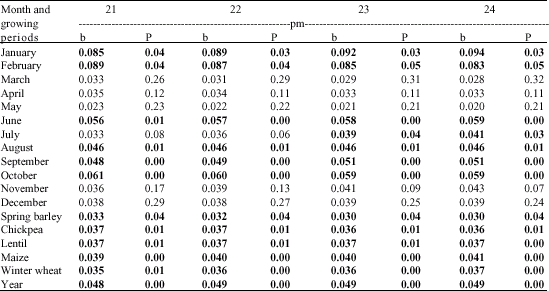 | |
| The bold values are statistically significant | |
| Table 6: | The rate of change (value of b in equation Y = a+bX) and its probability level (P) for averaged maximum temperature (Tmax), minimum temperature (Tmin) and mean temperature over month, over growing period of 5 crops and over year ( °C year-1) during past 39 years for Tabriz, Iran |
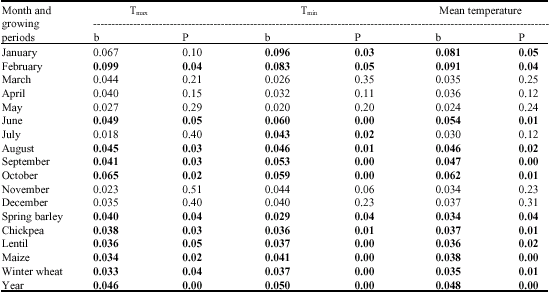 | |
| The bold values are statistically significant | |
been found for many other regions (Vose et al., 2005; Gholipoor et al., 2006; Ghorbani and Soltani, 2002), there is considerable difference between months for temperature change; more over, except for August and growing period of lentil, rate of change is asymmetric for Tmax and Tmin which is similar to published reports for other regions/countries (Gholipoor et al., 2006; Xie and Cao, 1996). There are a number of possible factors, such as an increase in cloud cover, contributing to decreases in the diurnal temperature range (Easterling et al., 2000); urban heat island is another factor influencing climate, which often tends to manifest itself strongest during the nighttime h; increase in urbanization may differentially increase the Tmin relative to the Tmax (Karl et al., 1991).
Overall, hourly-based results indicating that in January and July, warming found to be significant only for nighttime (20 h to 8 am) and for nearly half of nighttime (23 h to 5 am), respectively; across these hours, rate of warming was higher in January compared to July; the highest warming rate was obtained for 2 h in January and for 1 to 3 h in July, then showed decreasing trend with hour decrementing/incrementing; in contrast to these results, the results obtained from Tmax-Tmin-based analyzing only showing that warming has been happened for Tmin; additionally, rate of warming is higher for January than for July. In August, rate of warming was equal to 0.045 and 0.046 °C year-1 for Tmax and Tmin, respectively; based on hourly-results it was appeared that negligibly prominent warming rate is related to (night time) 20 to 8 am (h). For February and October, in which the warming was faster for Tmax than for Tmin, warming rate tended to be the highest for 13 to 15 h and for 12 to 16 h, respectively; whereas it appeared to be lowest in 2 am h and 1-3 am h for named months, respectively; across day and night hours, rate of warming was higher in February than October. Despite of February and October, in June and September, rate of warming was higher for Tmin, as compared to Tmax; more detailed results, which are only obtainable from hourly-based analyzing, indicate that there is no difference between June and September for time of occurrence of highest warming rate (1 to 3 am h) and that of lowest warming rate (13-15 h); warming rate was relatively higher for June, compared to September. It showed relatively prominent state at nighttime h for growing period of wheat (the highest rate obtained for 24 to 4 am h; the difference between Tmax and Tmin for warming rate was equal to 0.004 °C year-1), maize (24 to 4 am; 0.007), for yearly period (1 to 3 am; 0.004), but at daytime h for that of chickpea (9 am to 19; 0.002) and barley (13 to 15; 0.011); negligibly faster warming was related to night time h for lentil (21 to 7 am; 0.001).
CONCLUSION
Generally results indicate that in March, April, May, November and December, warming was not significant for all day time and night time hours. February and October with faster warming rate at daytime h appeared to have highest warming rate for h 13-15 and 12-16, respectively; the difference for lowest warming rate was also sensible (hour 2 am versus 1-3 am). Despite of these two months, June and September with more prominent warming at daytime h showed no difference for time of occurrence of highest 1-3 am (h) and for that of lowest (13-15 h) warming rate. In August, the negligibly faster warming (0.046 versus 0.045 °C year-1) was related to 20 to 8 am (h). In January and July, warming found to be significant only for nighttime 20 to 8 am (h) and for nearly half of nighttime 23 to 5 am (h), respectively; based on this difference and on existence of relatively higher warming rate for January, it is concluded that when there is significant change only for Tmin, it will be expected a proportional relation between rate of change for Tmin and number of nighttime h with temperature change; this conclusion may be true for Tmax, which should be confirmed in future studies. Based on huge difference between months for temperature change and on this fact that with changing scale from month to growing period of crops and finally to yearly period, variations are hidden, it seems that more variations may be exist between days of each month, which should be studied in future investigations.
Overall, when rate of change is asymmetric for Tmin and Tmax [as it is evident in most reports (Karl et al., 1993; Gholipoor et al., 2006; Ghorbani and Soltani, 2002), hourly-based-analyzing provides more-detailed results and therefore increased insights, compared to Tmax-Tmin-based-analyzing; for better understanding, suppose that in 9 April 1971, the temperature has equaled to 8.20, 7.40, 6.80, 6.10, 6.80, 7.40 and 8.20 °C for 23, 24, 1, 2, 3, 4 and 5 am (h), respectively; if climate-change-resulted increase in temperature of theses h has been 0.94, 0.96, 0.98, 1.00, 0.98, 0.96 and 0.94 °C/30 year, it will be cleared that the h with temperature-constraint has been diminished from 5 h in 1971 to 1 h in 2000, for, e.g., a plant with base temperature 7.5 °C; such relatively comprehensive results may be more useful for selecting appropriate climate-change-related managing/breeding programs for plants, due to this fact that the plant growth and development processes, including respiration, are continuous at different day and night moments.